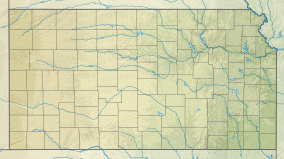| Brown v. Board of Education National Historical Park | |
|---|---|
| Location | Topeka, Kansas, and Summerton, South Carolina, United States |
| Nearest city | Topeka, Kansas |
| Coordinates | 39°02′17″N 95°40′35″W / 39.03806°N 95.67639°W |
| Area | 1.85 acres (0.75 ha)[1] |
| Established | October 26, 1992 |
| Visitors | 16,886 (in 2011)[2] |
| Governing body | National Park Service |
| Website | Brown v. Board of Education National Historic Site |
Brown v. Board of Education National Historic Site | |
| Location | 1515 SE Monroe St, Topeka, Kansas |
| NRHP reference No. | 01000156[3] |
| Added to NRHP | October 26, 1992 |
Brown v. Board of Education National Historical Park was established in Topeka, Kansas, on October 26, 1992, by the United States Congress to commemorate the landmark decision of the U.S. Supreme Court in the case Brown v. Board of Education aimed at ending racial segregation in public schools. On May 17, 1954, the Supreme Court unanimously declared that "separate educational facilities are inherently unequal" and, as such, violated the Fourteenth Amendment to the United States Constitution, which guarantees all citizens "equal protection of the laws."
The National Historical Park consists of Monroe Elementary School, one of the four segregated elementary schools for African American children in Topeka, and the adjacent grounds. It was originally known as Brown v. Board of Education National Historic Site until it was redesignated and expanded on May 13, 2022.[4] The Park will also include Summerton High School and Scott’s Branch High School in Summerton, South Carolina, upon acquisition of property. Five additional schools were authorized as affiliated areas of the National Park Service: Robert Russa Moton School in Farmville, Virginia; Howard High School in Wilmington, Delaware; Claymont High School in Claymont, Delaware; Hockessin Colored School #107 in Hockessin, Delaware; and John Philip Sousa Junior High School in Washington, D.C. The National Park Service will not own these sites but will provide financial and technical assistance to exhibit their history.[4]
The Brown v. Board of Education case was consolidated with four other cases on school segregation: Briggs v. Elliott (filed in South Carolina), Davis v. County School Board of Prince Edward County (filed in Virginia), Gebhart v. Belton (filed in Delaware), and Bolling v. Sharpe (filed in Washington, D.C.). Inclusion of the history of these schools will show a broader story of educational racism and the legal fight against it.
- ^ "Listing of acreage – December 31, 2011" (XLSX). Land Resource Division, National Park Service. Retrieved December 26, 2012. (National Park Service Acreage Reports)
- ^ "NPS Annual Recreation Visits Report". National Park Service. Retrieved December 26, 2012.
- ^ "National Register Information System". National Register of Historic Places. National Park Service. July 9, 2010.
- ^ a b "President Biden Signs Law to Expand and Redesignate Brown v. Board of Education National Historical Park". U.S. Department of the Interior. May 12, 2022. Retrieved May 13, 2022.

